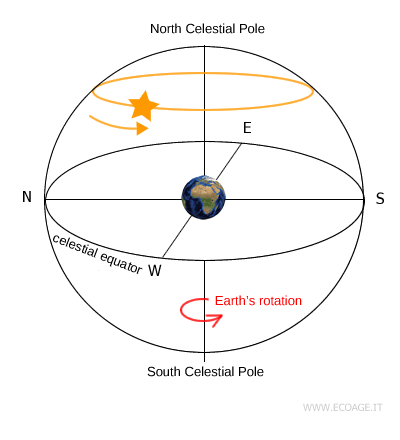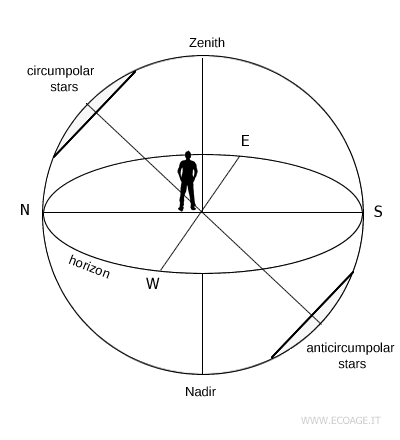Apparent rotation of the celestial sphere
The rotation of the Earth on its axis creates the day - night cycle and produces what we call the apparent motion of the celestial sphere. Because the Earth spins from west to east, the Sun, the Moon and the stars seem to move in the opposite direction, rising in the east and setting in the west. During a single day, each object crosses the celestial meridian twice: first at its highest point above the horizon, known as the upper culmination, and later at its lowest point, known as the lower culmination. What we see in the sky, and the path followed by each star, depends entirely on our latitude.
- At the equator, the celestial poles lie on the horizon. Stars spend exactly half of their daily path above the horizon and rise and set along lines that are perpendicular to it.

- At the poles, the celestial equator coincides with the horizon. Here, the stars move in perfect circles around the sky without ever rising or setting. From these locations, stars from the opposite hemisphere are permanently out of view.
- At mid-latitudes, the effect is intermediate. Some stars rise and set, while others trace arcs of different heights across the sky.
Among all the visible stars, a small group has a unique behavior. These are the circumpolar stars, which lie close to the celestial pole and never dip below the horizon. They remain visible throughout the night, circling the pole and appearing at both upper and lower culmination. In mid-northern regions, such as Italy, well-known circumpolar constellations include Ursa Major, Ursa Minor, Cassiopeia, Cepheus, and Draco. These constellations rotate endlessly around the north celestial pole and can be observed at any time of year.

The opposite case is represented by the so-called anticircumpolar constellations, such as the Southern Cross, Octans, Dorado, and Chamaeleon. They are located so far from the celestial pole that they never rise above the horizon in northern latitudes and remain permanently hidden from view.
In the southern hemisphere, this situation is reversed. Constellations that are circumpolar in the north become anticircumpolar in the south, and vice versa. For observers in mid-southern latitudes, Ursa Major and Ursa Minor disappear completely, while the Southern Cross, Octans, and Dorado remain constantly above the horizon, circling the south celestial pole. This reversal is entirely due to the observer’s latitude and the geometry of the Earth.
